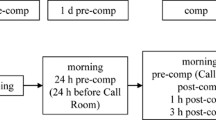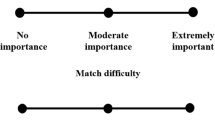Abstract
Competitive taekwondo composes a high stress situation leading to an increase in the stress hormone cortisol. Little is known about cortisol’s relation to outcome (winning vs. losing) and performance in taekwondo. Therefore, the aim of the study was to investigate cortisol relation to outcome, performance and whether cortisol can predict performance during a competition. Twenty taekwondo combatants (13 males; Mage = 15) provided four salivary samples (C1: 30 min prior, C2: during, C3: after, and C4: 30 min after competition) during an international competition. Total points made in the two rounds during their first fight were used as a performance indicator. Results show no difference in cortisol between winners and losers, before or after competition. However, a negative correlation between performance and C1 as well as C4 was detected. Unexpected, a positive correlation between cortisol during the competition (C2) and performance was identified. A stepwise multiple regression analyses showed that C2 predicted 25.5% of the performance variance. Even if the sample size is relatively small due to the field experimental setting, some conclusions can be drawn to motivate future research. Potentially, in taekwondo it seems advantageous for performance to have higher levels of stress as indicated by cortisol during a competition, whereas particularly before the competition, sport psychological interventions should be provided to combatants to reduce their psychophysiological stress level.
Similar content being viewed by others
Change history
14 August 2018
The original version of this article unfortunately contained a mistake in text under “Subject” section. The text portions masked for peer review were erroneously overlooked during the later stage “[country deleted to maintain the integrity of the review process]” and “[organization deleted to maintain the integrity of the review process]” should be replaced with “German” and “Bundesinstitut für Sportwissenschaft” respectively.
References
Beis, K., Tsaklis, P., Pieter, W., & Abatzides, G. (2001). Taekwondo competition injuries in Greek young and adult athletes. European Journal of Sports Traumatology and Related Research, 23, 130–136.
Capranica, L., Lupo, C., Cortis, C., Chiodo, S., Cibelli, G., & Tessitore, A. (2012). Salivary cortisol and alpha-amylase reactivity to taekwondo competition in children. European Journal of Applied Physiology, 112(2), 647–652.
Coelho, R. W., Keller, B., & Da Silva, A. M. B. (2010). Effect of pre- and postcompetition emotional state on salivary cortisol in top-ranking wrestlers. Perceptual and Motor Skills, 111(1), 81–86. https://doi.org/10.2466/05.06.25.PMS.111.4.81-86.
Crewther, B. T., Heke, T., & Keogh, J. W. (2011). The effects of training volume and competition on the salivary cortisol concentrations of Olympic weightlifters. The Journal of Strength & Conditioning Research, 25(1), 10–15. https://doi.org/10.1519/JSC.0b013e3181fb47f5.
Crewther, B. T., Keogh, J., Cronin, J., & Cook, C. J. (2006). Possible stimuli for strength and power adaptation. Acute hormonal responses. Sports Medicine, 36, 215–238. https://doi.org/10.1519/JSC.0b013e3182946110.
Dickerson, S. S., & Kemeny, M. E. (2004). Acute stressors and cortisol responses: A theoretical integration and synthesis of laboratory research. Psychological Bulletin, 130(3), 355. https://doi.org/10.1037/0033-2909.130.3.355.
Doan, B. K., Newton, R. U., Kraemer, W. J., Kwon, Y. H., & Scheet, T. P. (2007). Salivary cortisol, testosterone, and T/C ratio responses during a 36-hole golf competition. International Journal of Sports Medicine, 28(6), 470–479. https://doi.org/10.1055/s-2006-924557.
Elias, M. (1981). Serum cortisol, testosterone and testosterone-binding globulin responses to competitive fighting in human males. Aggressive Behavior, 7, 215–224.
Faul, F., Erdfelder, E., Lang, A. G., & Buchner, A. (2007). G*power 3: A flexible statistical power analysis program for the social, behavioral, and biomedical sciences. Behavior Research Methods, 39, 175–191. https://doi.org/10.3758/BF03193146.
Filaire, E., Maso, F., Sagnol, M., Ferrand, C., & Lac, G. (2001). Anxiety, hormonal responses, and coping during a judo competition. Aggressive Behavior, 27(1), 55–63. https://doi.org/10.1002/1098-233720010101.
Kazemi, M., Waalen, J., Morgan, C., & White, A. R. (2006). A profile of Olympic taekwondo competitors. Journal of Sports Science & Medicine, 5(CSSI), 114.
Lautenbach, F., & Laborde, S. (2016). The influence of hormonal stress on performance. In M. Raab, B. Lobinger, S. Hoffmann, A. Pizzera & S. Labode (Eds.), Performance psychology–perception, action, cognition and emotion (pp. 315–328). Amsterdam: Academic Press Elsevier. https://doi.org/10.1016/B978-0-12-803377-7.00019-3.
Lautenbach, F., Laborde, S., Achtzehn, S., & Raab, M. (2014). Preliminary evidence of salivary cortisol predicting performance in a controlled setting. Psychoneuroendocrinology, 42, 218–224. https://doi.org/10.1016/j.psyneuen.2014.01.011.
Lautenbach, F., Laborde, S., Klämpfl, M., & Achtzehn, S. (2015). A link between cortisol and performance: An exploratory case study of a tennis match. International Journal of Psychophysiology, 98(2), 167–173.
Passelergue, P., & Lac, G. (2012). Salivary hormonal responses and performance changes during 15 weeks of mixed aerobic and weight training in elite junior wrestlers. Journal of Strength and Conditioning Research, 26, 3049–3058. https://doi.org/10.1519/JSC.0b013e3182473e3d.
Passelergue, P., Robert, A., & Lac, G. (1995). Salivary cortisol and testosterone variations during an official and a simulated weight-lifting competition. International Journal of Sports Medicine, 16(5), 298–303. https://doi.org/10.1055/s-2007-973009.
Pilz-Burstein, R., Ashkenazi, Y., Yaakobovitz, Y., Cohen, Y., Zigel, L., Nemet, D., et al. (2010). Hormonal response to Taekwondo fighting simulation in elite adolescent athletes. European Journal of Applied Physiology, 110(6), 1283–1290.
Putman, P., Antypa, N., Crysovergi, P., & van der Does, W. A. (2010). Exogenous cortisol acutely influences motivated decision making in healthy young men. Psychopharmacology, 208(2), 257.
Putman, P., & Roelofs, K. (2011). Effects of single cortisol administrations on human affect reviewed: Coping with stress through adaptive regulation of automatic cognitive processing. Psychoneuroendocrinology, 36(4), 439–448. https://doi.org/10.1016/j.psyneuen.2010.12.001.
Quergui, I., Davis, P., Houcine, N., Marzouki, H., Zaoual, M., Franchini, E., Gmada, N., & Bouhlel, E. (2016). Hormonal, physiological, and physical performance during simulated kickboxing combat: Differences between winners and losers. International Journal of Sports Physiology and Performance, 11, 425–431. https://doi.org/10.1123/ijspp.2015-0052.
Robazza, C., Gallina, S., D’Amico, M. A., Izzicupo, P., Bascelli, A., Di Fonso, A., et al. (2012). Relationship between biological markers and psychological states in elite basketball players across a competitive season. Psychology of Sport and Exercise, 13(4), 509–517. https://doi.org/10.1016/j.psychsport.2012.02.011.
Roelofs, K., Bakvis, P., Hermans, E. B., van Pelt, J., & van Honk, J. (2007). The effects of social stress and cortisol responses on the preconscious selective attention to social threat. Biological Psychology, 75, 1–7. https://doi.org/10.1016/j.biopsycho.2006.09.002.
Rohleder, N., Beulen, S. E., Chen, E., Wolf, J. M., & Kirschbaum, C. (2007). Stress on the dance floor: The cortisol stress response to social-evaluative threat in competitive ballroom dancers. Personality and Social Psychology Bulletin, 33(1), 69–84. https://doi.org/10.1177/0146167206293986.
Salvador, A., & Costa, R. (2009). Coping with competition: Neuroendocrine responses and cognitive variables. Neuroscience & Biobehavioral Reviews, 33(2), 160–170. https://doi.org/10.1016/j.neubiorev.2008.09.005.
Salvador, A., Suay, F., Gonzalez-Bono, E., & Serrano, M. A. (2003). Anticipatory cortisol, testosterone and psychological responses to judo competition in young men. Psychoneuroendocrinology, 28(3), 364–375. https://doi.org/10.1016/S0306-4530(02)00028-8.
Schweizer, G., & Furley, P. (2016). Reproducible research in sport and exercise psychology: The role of sample sizes. Psychology of Sport and Exercise, 23, 114–122.
Toone, R. J., Peacock, O. J., Smith, A. A., Thompson, D., Drawer, S., Cook, C. J., et al. (2013). Measurement of steroid hormones in saliva: Effects of sample storage condition. Advance online publication. Scandinavian Journal of Clinical and Laboratory Investigation, 73, 615–621. https://doi.org/10.3109/00365513.2013.835862.
Westermann, J., Demir, A., & Herbst, V. (2004). Determination of cortisol in saliva and serum by a luminescence-enhanced enzyme immunoassay. Clinical Laboratory, 50, 11–24.
Acknowledgements
We would like to thank the Bundesinstitut für Sportwissenschaft for their financial support. Further we would like to thank all the athletes who took the time before, during and after a stressful competition to provide us with salivary samples. Also, we thank the sport psychological expert Werner Mickler, the head coach Marko Scheiterbauer and the physiotherapist for their cooperation and their help collecting data during the competition. Finally, we thank the Institute of Psychology, Performance Psychology group for their critical feedback on the manuscript and Anita Todd for proof-reading of the manuscript.
Author information
Authors and Affiliations
Corresponding author
Ethics declarations
Conflict of interest
There is no conflict of interest.
Rights and permissions
About this article
Cite this article
Lautenbach, F., Lobinger, B.H. Cortisol Predicts Performance During Competition: Preliminary Results of a Field Study with Elite Adolescent Taekwondo Athletes. Appl Psychophysiol Biofeedback 43, 275–280 (2018). https://doi.org/10.1007/s10484-018-9406-4
Published:
Issue Date:
DOI: https://doi.org/10.1007/s10484-018-9406-4




